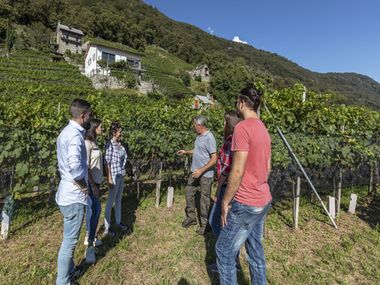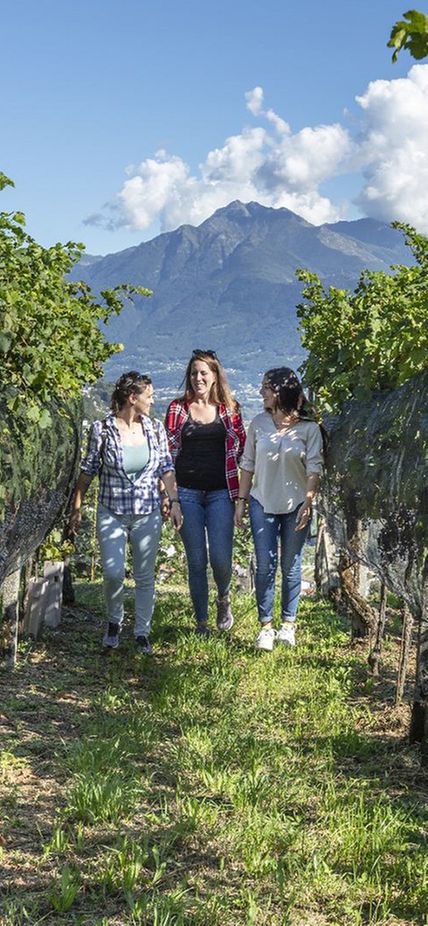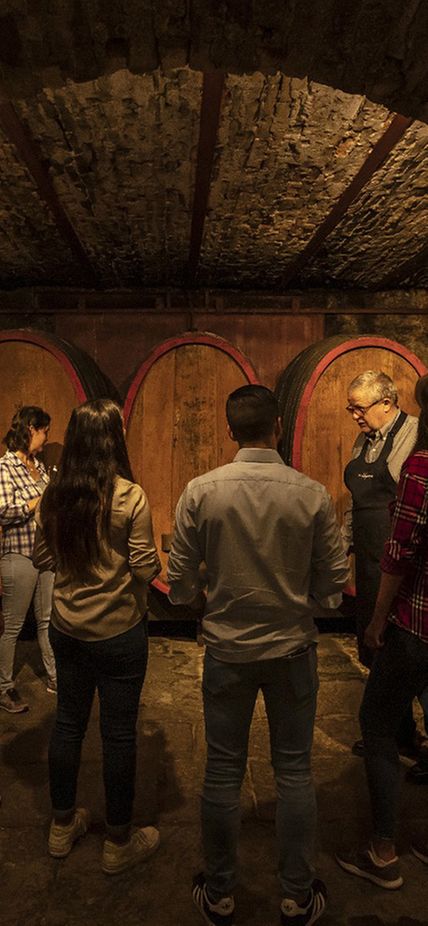Long rows of vines criss-cross the plains and hills with beautiful views of lakes, valleys and rivers. An intense, sweet but delicate fragrance is in the air. Ticino is renowned for the quality of its wines, especially Merlot, which accounts for 83% of the grapes grown in the canton (state). An excursion by bike or on foot through vineyards and wineries to get in the mood for autumn and learn more about the wines of the Lago Maggiore region.
Ticino is famous for its Merlot. In fact, it is the most important grape variety grown in our area. Of the slightly more than 1000 hectares of vineyards, about 860 are planted with Merlot. It is followed by the Americana, Chardonnay, Bondola and Pinot Noir grape varieties, which share 20 % of the cultivated area. The Bondola grape in particular is native to Ticino and was also the most widespread until the beginning of the 20th century. Today it has been displaced by Merlot and is only grown in Ticino, especially in the Ascona-Locarno region. But why is it precisely the Merlot that has enjoyed such great success? To find out, we have to dig around in the past a bit and brush up on the history of viticulture. In the early 1900s, a terrible phylloxera epidemic destroyed the native vines in Ticino (and in the rest of Europe too), and so it was necessary to look for a grape variety that was resistant to the disease. The first trials with the Merlot grape were successful and cultivation was strongly encouraged by the canton.

Thanks to the techniques of the winegrowers and the special microclimate of Ticino, with its mild winters and Mediterranean summers, Merlot is now also used to produce sparkling, white and rosé wines. Merlot vinified white (also made from red grapes) is a Ticino speciality. That is why only 9 % of the grapes grown in Ticino are white. The grapes in Ticino are usually ripe by the end of September, but it is highly dependent on the weather conditions. Merlot produces intense, ruby-red, balanced wines with a good body. Ticino has different soils in the north and the south, which is why the Sottoceneri and the Sopraceneri produce very different wines from the same grapes. The gneiss and granite soils in the Ascona-Locarno region are more acidic and lighter and are reflected in the character of the wines. Of course, you have to taste the wines to notice: This is where the impressive wine cellars come into play, with their barrels in which the good wine matures and the bottles stacked end to end on the shelves.
Some of the wineries of Ascona-Locarno enjoy a particularly stunning view and immediately make you feel like you're on holiday, such as Cantina Carrara. Others are not just wineries, but real worlds to explore. Like the Matasci winery, for example, where not only is wine made, but the history of wine is carried on and the art is promoted. Among the many, there are also heroic vineyards - those hidden vineyards that are difficult to reach and cultivate because they are located in inaccessible or almost inaccessible areas - such as the Vigneto della Pioda above Maggia and one of the highest vineyards in Ticino, located in Brontallo at over 700 m.a.s.l., an altitude where grapes normally find it difficult to ripen.
The Lago Maggiore region is rich in such hidden bijous: half of the region's vineyards are considered difficult to cultivate because of their location, accessibility and soil conditions. The result is rare wines that are worth tasting: Who knows, maybe it will become your new favourite wine.


